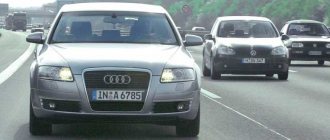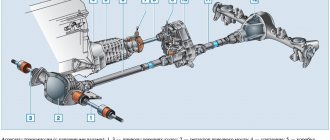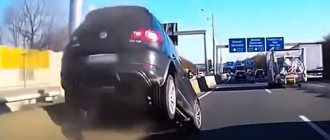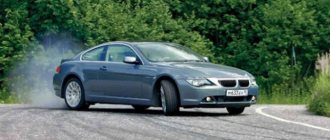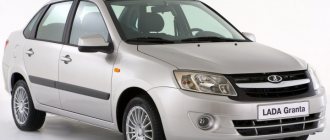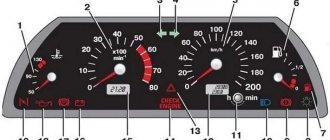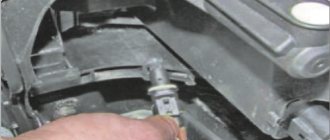Good afternoon, dear reader.
This article will review the rules of the road that apply to the use of vehicle headlights and lights in various driving situations.
Lighting devices are designed both to illuminate the road ahead of the car (to avoid collision with an obstacle) and to indicate the car itself (to avoid collision with other vehicles).
Unfortunately, many drivers do not know the rules for using headlights and flashlights, and therefore do not use all the opportunities provided to them.
- in good visibility;
- at night on an unlit road;
External car lights
At the beginning of this article, a few words about what external lighting devices a car may have. This information is primarily intended for those who are studying at a driving school and do not yet understand what these or other headlights or lanterns are intended for.
Note. The topic “lighting devices” is one of the most difficult in a driving school, because... It is difficult for a driver candidate who has never driven before to remember the similar names of light devices and the rules for their use.
parking lights
Dimensions are small light devices located approximately at the corners of the car (4 pieces in total). They do not shine very brightly and are primarily designed so that drivers of other cars can understand in the dark where your car begins and ends.
As a rule, the car is designed in such a way that when you turn on the low or high beam headlights, the dimensions turn on automatically. That is, low beam without side lights does not work.
Daytime Running Lights
DRLs are light devices in the front of the car (2 pieces), which shine quite brightly. They are designed to improve visibility of the car from the front during daylight hours.
Daytime running lights should not be used at night because... at night, they can blind oncoming drivers due to their high brightness. However, they do not illuminate the road.
In 2022, most cars are equipped with daytime running lights, but such lights are quite rare on cars manufactured before 2010.
Low and high beam headlights
Low beam (2 bulbs) and high beam (2 bulbs) headlights are the main lighting devices that are designed to illuminate the road in front of the car.
In this case, the low beam illuminates the area directly in front of the car, and the high beam illuminates a more distant area. It makes sense to use low beam at low speeds, high beam at higher speeds.
Fog lights
PTF - 2 headlights in the front bumper of a car, designed to illuminate the road in poor visibility conditions.
Fog lights are optional for 2022, so not all vehicle trim levels have them. That is, the car may not have PTF.
Fog light
Fog light - a red light at the rear of the vehicle, designed to improve visibility of the vehicle in poor visibility conditions. This light device is very bright and in good weather it can blind drivers of cars behind.
This lamp is required to be installed on all cars.
How is a violation recorded?
The issue of imposing a fine for not turning on the low beams is dealt with by traffic police officers from the moment the violation is detected until the punishment is imposed.
As a rule, after identifying a violation on the spot, a resolution on administrative liability is drawn up.
Not in all cases you should agree with the traffic police officer.
You can prove a traffic violation for low beam headlights during the day if:
- there are witnesses to the offense;
- driving recorded on video;
- The driver himself admits his guilt.
Therefore, if no evidence is presented, the driver can safely defend his truth. Such materials are easily challenged in court.
If the fact of a violation is undeniable, one should strive to reduce everything to a warning. That is, do not conflict, talk about driving without a penalty, remind about the possibility of warning, etc.
Driving during daylight hours
In good visibility
When driving during daylight hours, the vehicle must have one of the following lights on:
- low beam;
- Daytime Running Lights;
- fog lights;
If the car has all the listed devices, then it makes sense to use DRL. These lights are brighter and use less electricity.
When driving, the following can also be turned on:
- parking lights.
It is prohibited to use:
- fog lamp.
In case of insufficient visibility
One of the following lighting fixtures must be used:
- low beam headlights;
- high beam headlights.
In this case, the main beam cannot be used:
- in populated areas on illuminated roads;
- when oncoming vehicles pass;
- when blinding drivers of passing or oncoming cars.
Additionally, the car may include:
- fog lights;
- fog lamp;
- parking lights;
- Daytime Running Lights.
Note. The rear fog light is specifically designed for use in conditions of poor visibility, but in practice no more than 10 percent of drivers use it. The rest, apparently, do not know the relevant rules.
Possible penalties
If we start from section 19 of the current Traffic Rules, then if any of the requirements stipulated in the document are violated, liability arises. It is determined based on Article 12.20 of the Administrative Code.
This article has 2 possible sanctions:
- warning;
- money penalty.
The decision is made at the discretion of the inspector who recorded the offense. In this case, the fine is 500 rubles.
The driver will be given a warning or fine if:
- he drives at night only in PTF;
- did not switch from high to low when an oncoming car approached at a distance of less than 150 meters;
- PTF or low beam headlights were not turned on during the day;
- rear fog lights are used in different conditions, except poor visibility, etc.
The inspector determines which sanction should be used against the offender. The department employee relies on the presence of aggravating or mitigating circumstances, which is also provided for by law.
When imposing a monetary fine, the violator has the right to pay only half the amount, thereby receiving a 50% discount. This is possible if, after the decision is made, the fine is repaid within 20 days.
It should be added that such sanctions apply only to the improper use of vehicle lighting devices, which fully comply with all requirements and standards. If the headlights do not meet technical standards, then much more serious penalties are provided.
Let's give a simple example. The headlights are a color other than white, yellow or orange. The driver installed films or used paint, which made the light red. For such a violation, deprivation of rights for a period of 6-12 months is possible. Additionally, the inspector undertakes to seize lighting devices that do not meet the established requirements.
Driving in the dark
One of the following lighting fixtures must be used:
- low beam headlights;
- high beam headlights.
In this case, the main beam cannot be used:
- in populated areas on illuminated roads;
- when oncoming vehicles pass;
- when blinding drivers of passing or oncoming cars.
Additionally you can use:
- fog lights;
- fog lamp (only in case of poor visibility);
- parking lights.
Fine for a non-working headlight
Often, owners of vehicles that are not equipped with a system for auto-checking the performance of vehicle devices overlook the malfunction of the lighting device. It is worth noting that a failed headlight or a burnt-out side light does not constitute a violation in the use of vehicle lighting equipment.
When driving with one headlight on, the driver only violates paragraph 3.3 of the traffic rules, which regulates the list of obstacles to using the vehicle legally until the cause of the violation is eliminated. Thus, operation of the car cannot be resumed until the headlight is restored or the light elements are cleaned (the driver cannot use dirty devices, as this impairs the visibility of the signals).
According to part one of Article 12.5 of the Code of Administrative Offences, punishment for one faulty headlight is a warning or a fine of 500 rubles.
Stopping and parking a car
At night on an unlit road
Must be included:
- parking lights.
It is prohibited to use:
- fog lamp.
Other lighting devices can be used.
In case of insufficient visibility (during dark or daylight)
Must be included:
- parking lights.
Other lights, including the rear fog lamp, may be used.
Why are headlights needed during the day?
There are several reasons why you should turn on a lighting fixture:
- Often a traffic police officer stops a driver because the lights are out. And, in addition to a fine for driving without headlights, this becomes a reason to look for other violations;
- Of course, this is a security issue. Both the other driver and the pedestrian see you. This will avoid many troubles on the road;
- When the lights are on, the instrument panel in the cabin also lights up. Such information is important for the motorist.
Possible causes of malfunction
So, if the low beam in one of the headlights of a Lada Kalina does not light up, then the reason most likely lies in a burnt-out light bulb.
Replacing it will not be difficult for every car owner. However, unfortunately, there are a number of other reasons for this malfunction, the most common of which are the following:
- The contacts in the plug block are oxidized or burnt;
- The fuse has blown;
- Open circuit;
- The relay has failed.
Below we will look at how to fix all these problems.
H7 standard bulb
Replacing the lamp
Replacing the low beam on Kalina is quite simple. Moreover, you will only have to spend a few minutes of your time on this.
The only thing is that before replacing old lamps, you need to purchase new ones of the H7 standard. It is advisable to install new bulbs on two headlights at once so that they provide the same glow.
Removing the plug
Replacement instructions are as follows:
- First of all, you need to remove the rubber plug located on the back of the headlight. To do this, you must first open the hood.
- Then you need to remove the positive and negative terminals from the contacts.
Releasing the latch from the landing
- Next, you need to press the spring bracket with your own hands and remove it from the seat.
- After this, you need to remove the old light bulb and put a new one in its place.
- Then you need to replace the bracket, put the terminals on the contacts and install the plug.
When replacing light bulbs, you need to pay attention to the quality of the contacts. If the contacts are oxidized or burnt, they must be cleaned. Fuse and relay block Lada Kalina
Fuse and relay block Lada Kalina
Replacing the fuse
If, after replacing the lamps, the low beam headlights in the Lada Kalina still do not work, you should check the fuses. They are located in the mounting block under the steering wheel.
The lamps are protected by different fuses:
- Right lamp – F12
- Left lamp – F13
It must be said that it is not always possible to visually identify a blown fuse. Therefore, even if it has no external defects, you should check the voltage at the terminals with a test lamp or multimeter.
Lada exterior lighting diagram
Open circuit
If the fault cannot be eliminated, then you need to find an open circuit.
You can do this as follows:
- If there is no voltage at the fuse terminals, you need to ring the wire that goes from F13 to contact No. 56 of the lighting control unit, since you can turn on the low beam headlights on Kalina using switch No. 5.
- If the wire is intact, but 2 headlights do not light, then switch No. 56 must be replaced. However, you should first check whether voltage is supplied to the switch itself.
- If voltage is supplied to fuses F13 and F12, you should check whether there is voltage at the relay output. Let us remind you that the low beam relay in the Lada Kalina is located in the mounting block.
- If there is no voltage, you should check the area from F12 to contact No. 56 of switch No. 4, which is located on the steering wheel, as well as the area from terminal No. 56a to terminal 1 of relay K7. It is also quite possible that switch No. 4 or the relay itself is not working.
Replacing the latter is not difficult, since it is simply inserted with contacts into the socket.
In the photo - lighting relay Lada Kalina
In cases where there is voltage at the relay output, you should check the wiring of the machine from the mounting block to the headlights according to the diagram.
As we can see, finding an open circuit or a faulty part is not difficult. To do this, you only need a low beam circuit on Kalina and a multimeter or test light. These are, perhaps, all the main reasons for this malfunction on the Lada Kalina car.
The problem is the power of the light bulb
A typical problem for domestic cars, as well as for some budget foreign cars. From the factory, they are equipped with light bulbs of the minimum power, which is permissible for use in accordance with the technical regulations. And such lamps usually do not differ in quality.
Consequently, their glow level is low, and their service life leaves much to be desired.
This is a case where there are no significant problems or malfunctions. But the headlights still don't shine bright enough.
The problem is solved extremely simply. You need to take a new light bulb with sufficient power that will meet the requirements of the car itself. It is better to take products from well-known brands such as Osram, Philips, Bosch and others.
You definitely shouldn’t rely on cheap Chinese light bulbs. Often the stated characteristics do not correspond to reality. Plus, they fail quickly, without using up even half of their required resource.
Cameras have learned to detect turned off headlights - is this true?
Yes. Just as cars themselves have long been able to see the lights on oncoming cars, which is used in systems for automatically switching headlights from high to low and vice versa, cameras for automatically recording violations are also able to see the beam of light emitted from the car. In addition, video and photo recording tools have already taught us to determine where the headlights themselves are located on the car.
However, just recently one of the developers and installers of fixation devices reported that it was their cameras that had learned to recognize when the lights were off.
However, all this becomes important for us as car enthusiasts from the point of view of specific financial risks.
How to use them correctly
Having dealt with the controls for the optics of high and low road lighting, it is worth understanding the advisability of using this or that light. The legislation specifies factors that determine the type of headlights used:
- place - populated area, country highway, tunnel;
- time - daytime or nighttime;
- degree of illumination - illuminated or unlit road;
- finding transport in motion, stopping or parking;
- distance to other traffic participants driving motor vehicles.
What to do if the headlight suddenly stops working
Recommended actions:
- calling a tow truck;
- towing by other vehicles;
- waiting for daylight.
During the day, the Rules allow you to reach a service station or parking lot with unlit lighting equipment.
If none of the proposed options is suitable, the motorist proceeds in the following sequence:
- Turns on the hazard warning lights and stops the vehicle on the side of the road.
- Checks the functionality of the DRL, PF and side lights.
- If the lights are working properly, it lights up all available ones and starts driving at low speed in the right lane. If the lights are not working, the car must be removed from the roadway (clause 19.4), and if this is not possible, it must be marked with a warning triangle or a flashing red light (clause 9.11).
If all on-board lighting turns out to be inoperative, take the following measures:
- attach to the bumper using improvised means or hold a flashlight in your hands;
- install a warning triangle with reflectors on the shelf near the rear window.
After this, they begin to move at low speed. It is advisable to line up behind another slowly moving vehicle - a truck, for example. This solution will help avoid a collision with an oncoming car.
In order not to be left at night without light, you should read the instructions regarding replacing relays and lamps, and also have several spare parts with you.
Cancel the use of low beam
Recently, changes have often been made to traffic rules, so many drivers have a question: do they need to turn on headlights during the day in the city from 2022?
Indeed, the traffic rules have undergone a number of changes, but this did not affect the procedure for using lighting devices. Therefore, all this is from the category of rumors and assumptions.
So far there are no prerequisites for this. The obligation to use headlights during the day has existed for 8 years. And this has only a positive effect.
Perhaps this need will be canceled. To do this, an official document will be published that will contain information from what date you can not turn on the low beam.
Rules of paragraphs 6 and 7 of Article 19
Rotating lighting devices (called a spotlight or searchlight) are turned on, according to paragraph 6, only outside the city or other populated area and only when there is no oncoming traffic. The exception is specialized vehicles moving around the territory of a populated area with flashing blue lights, accompanied by sound signals established by the rules. This vehicle must move in the direction of the object that is the reason for the performance of the official task, which is determined to be urgent.
Paragraph 7 specifies the rules for operating rear fog lights. They are turned on if necessary to reduce an emergency situation in conditions of poor visibility on the road. A ban is imposed on connecting this lighting equipment to brake lights.
When to turn it on and off
All cars have different design solutions for external lighting.
To move on to using the dimensions, you need to clearly know how they turn on and where the controls for these devices are located. This information is detailed in the vehicle's owner's manual.
Sometimes they simply forget about including dimensions. In older cars, this option was turned on simultaneously with the backlight; it was technically impossible to forget.
In modern vehicles, everything is separate: both lighting and dimensions. Turning the optics on and off in certain situations needs to be controlled.
Clause 19.3 of the traffic rules provides for the driver’s obligation to turn on the side lights in the following cases:
- When stopping (parking) at night on unlit road sections.
- In conditions of poor visibility. Additionally, simultaneous activation of daytime running lights, low beam headlights, and fog lights (headlights and rear lights) is allowed.
A significant decrease in visibility occurs under the following conditions:
- in heavy fog;
- at night and at dusk;
- during precipitation, snow or rain;
- when driving in a tunnel.
In conditions of limited visibility when stopping and parking, the driver is given the right to independently decide how to make the car more visible, which lighting devices need to be turned on additionally.
At the same time, we must not forget: even in difficult weather conditions, the choice of a place to stop and park is regulated by the Traffic Rules.
It is believed that movement is most difficult in the dark and in heavy fog. Don't wait until the fog makes the road indistinguishable.
It is better to turn on the lights even in light fog.
When stopping at night on the side of the road, to improve visibility, in addition to the side lights, you should turn on the hazard warning lights.
It’s better to make a rule for yourself: if it becomes worse to see, you need to turn on the dimensions. Do not forget that all drivers have different vision. It is really necessary to indicate the dimensions of the car, because in the dark a car without dimensions is just a ghost.
And also, practical advice: if the low beam of the headlights becomes visible on the road, it’s time to use the side lights.
But do the traffic police issue a fine for leaving the lights on now?
No. Despite the fact that you will find the most contradictory information about this latest news on the Internet, cameras that automatically record traffic violations as of December 7, 2022 do not send “chain letters” specifically for not turning on headlights, either day or night.
However, many publications on the Internet are disseminating information that such a system will be operational in the near future. However, this information was officially denied by the Russian Ministry of Internal Affairs.
Thus, today, auto-fixing systems do not issue traffic police fines for turning off the low beam headlights.
Moreover, this works for both times of day:
- cameras do not issue fines for not turning on headlights (or DRLs) as in the daytime,
- just as there is no automatic punishment for a more serious violation - turning off the lights at night.
Updated 08/10/2021. Meanwhile, a number of publications report that in practice, since July, active issuance of decisions has been carried out using automatic means of recording such a violation as not turning on low beam headlights. Moreover, for now such cameras only work in Nizhny Novgorod.
Methods for connecting fog lights
Connecting PTF can be done in several ways. The simplest one is if the car is equipped with fog lights from the factory, that is, the electrical circuit consists of all the necessary components: connectors, switch, connecting wires, fuse, relay.
Installation, in this case, consists of installing the headlights and connecting them to the power supply. This method can be used when the car is fully equipped, if you need to replace installed fog lights or to improve the lighting system.
If the basic configuration of the car does not include foglights, you will have to install the wiring yourself. To do this, you need to purchase the necessary components: a set of wires, a relay, a switch, etc. You can purchase a ready-made kit for installing fog lights. Know how fog lights are included in a car's electrical circuit (video author: Morgan One).
Some drivers doubt whether it is possible to connect fog lights to headlights. This cannot be done, since the switch and wiring in the side lights are not designed for the current consumed by the headlights.
Having purchased a universal kit for connecting fog lights, you can connect the fog lights yourself using the following algorithm:
Laying the wires must begin by dismantling the dashboard and connecting the relay. First you need to find the wire going to the instrument lighting. Following these wires, you can find a block that has a free connector to connect the fog light relay into. The second step is to connect the switch. If there is a free button on the dashboard, connect the headlights to it. If there is a free button, then you need to install a new one. The next step is to connect the relay to the battery. The wire from the battery must be connected to pin 87 of the relay
It is more convenient to run the wire under the pedals. It is important to include a fuse in the electrical circuit when installing. This will protect the lamps from burning out and will save you from a fire in the event of a short circuit
The fuse rating is calculated based on the power of the headlights. If you take 60 W bulbs, then the current to power the headlights will be: 2 * 60 W / 12 V = 10 A. The fuse must be selected with a high rating. In this case, it is necessary to use a fuse with a rating of 15 A. Now we mount the PTF in the bumper. Before installing the fog lights, you need to mark the locations for the headlights according to the requirements. It is better to install PTF on a removed bumper. After installation, the headlights must be securely fixed using the fasteners that come with the mounting kit. The negative wire must be shorted to ground (car body), the positive wire must be connected to the 30th contact of the relay. At the final stage, the relay is installed in its seat and secured. The instrument panel returns to its original location.
Photo gallery
1. PTF installation kit
2. Set of wires for connection
3. The process of pulling the wire to connect
4. Installation of the power button After installing the PTFs, you need to check their operation and adjust them. If your headlights are raised too much, they will lose their effectiveness when driving in bad weather conditions.
Do you prefer stylish, cool headlights? Then you need other lamps!
make the appearance of your car more stylish and modern . Their glow temperature is up to 5000 K , which is similar to the hue of xenon lamps . This is achieved by applying a blue filter to the bulb of the lamp, which blocks the red range of the emitted light and the color turns out whiter. OSRAM Cool Blue Intense halogen automotive lamps are ideal for use in headlights with clear lenses - the silver dome of these lamps optically merges with the reflector, resulting in an overall homogeneous composition.
Xenon or LEDs: which lamps to choose
Now let's look at what is better, xenon bulbs or LEDs.
Even if we discard all legal restrictions, if it is necessary to improve car lighting by replacing the standard halogen, the question arises, which is better, a xenon lamp or diode bulbs. So, it is important to understand that every decision has both pros and cons. Xenon lamps are capable of shining brightly and illuminate the road well. In this case, you should select the correct lamps according to the “temperature”. In short, 4300K xenon produces a more yellow glow, 5000K is closer to a blue-white light, while, for example, 6000K has a bluish-white glow.
So, the latest 6000K version illuminates a dry road well, but the light is “lost” in the rain, on wet asphalt, etc. In turn, xenon 4300K is optimal for rain, snow or fog, but on dry asphalt it may seem that it does not shine so brightly. It turns out that the best xenon lamp will be a high-quality 5000K option.
It is also important to understand that if xenon is installed in a headlight instead of halogen, and without modifications, such headlights will inevitably dazzle drivers of other vehicles. It is noteworthy that adjustments do not solve the problem completely. For this reason, it is recommended to install lenses in the headlights. Of course, costs increase, since the headlight will need to be disassembled and modified.
- With LEDs, things are also not so simple. First, the LED headlight has a special design. If you install such a lamp in halogen optics, the choice of solutions is limited and the price is higher. However, even if you can find such light bulbs, they are relatively easy to install, but the problems are not solved.
It is still recommended to modify the headlight. Since the LED lamp is bright, the situation resembles regular xenon without lenses in standard halogen optics. Glass with a reflective pattern refracts the light flux, causing stray light, which can lead to blinding of oncoming drivers.
As for LED lenses, such solutions exist, but the cost is quite high, and the quality of light compared to lensed xenon is questionable. The reason is the peculiarities of the LED light bulb itself, which illuminates the lens on the sides. If you remake the optics for lenses, it is easier to install a bilens and xenon.
In any case, to answer the question of what affects the quality of headlight light, you must consider the following:
- condition of the headlight and optics adjustment;
- type of lamp (halogen, xenon, LED lamps);
- characteristics of the headlight bulb itself (power, glow temperature);
- quality of finishing (presence or absence of a lens in the headlight), polishing of the optics, painting of the reflector, etc.
- correct installation of lighting equipment, etc.
Controversial situations and ways to resolve them
Although the amount of the fine by modern standards is not so large, if the driver is right, it is worth trying to prove it, at least as a matter of principle. Especially if the inspector simply begins to “put pressure” on the driver without any particular reason.
To begin with, when the inspector discovers a malfunction of the headlight (as, indeed, any similar one), it is worth politely informing that the movement was in the direction of the technical station. service or parking to correct this problem. Or simply pretend that the headlight burned out just about during the trip, but when it started it was properly performing its function. In this case, the driver can only get away with a verbal warning.
But it is worth remembering that with one working headlight you can only go to the place where the problem is corrected.
Problem with the reflector in the headlights
Most cars have halogen headlights. Yes, now LED optics options are rapidly gaining popularity. But they are still far from halogen devices.
The design of halogen optics includes reflectors. This item has a reflective, shiny metallic finish. It is when the surface of the reflector burns out that the intensity of the headlights changes, and even powerful lamps do not provide the required level of illumination.
This happens under the influence of time. But more often the problem is associated with the installation of lamps that have a higher operating temperature than provided by standard optics. In simple words, it is impossible to install more powerful lamps in headlights that are not designed for such parameters. Otherwise, the reflector will quickly burn out.
As for restoring the reflector, this procedure can be carried out in several ways.
- Complete replacement. This is the best way out of the situation. But the difficulty is that the headlight will have to be disassembled and reassembled. Without certain skills and knowledge, an ordinary motorist will not be able to do this. Therefore, it is better to contact specialized specialists.
- Metallized tape. The idea is to cover the working surface of the reflector using metallized tape. But it is better from a trusted manufacturer. The solution is not the best. Rather, it is suitable as a temporary measure until it becomes possible to replace the reflector.
- Metal foil. Another option to improve headlight performance. An alternative to metallic tape. But the work requires increased accuracy. The foil should be laid in a perfectly even layer on the headlight reflector. Otherwise, the light will be refracted, which will negatively affect the operation of the optics.
- Chrome paint. Again, this is more of a temporary option. Even the highest quality paints do not provide the required level of reflection when applied manually. The problem is partially solved.
Mirror film. Quite a good way out of the situation. Mirror films are sold in specialized stores. You need to glue it carefully.
When will they start?
This is not yet known. The developers of the complex themselves presented that 1.5 thousand new cameras will soon appear that can recognize this violation of the Traffic Rules:
- supposedly 600 of them will be installed in Moscow,
- and another 900 in large cities and regional capitals.
However, cameras do not currently detect headlights being turned off. The question of when they will start doing this remains open. But, most likely, not in the near future, since the system still needs to be tested for erroneously detected violations.
For comparison, the issue of identifying the absence of compulsory motor insurance from video recording cameras has been open for several years. Moreover, there were also official statements that the system would soon start working. But “the problem is still there” - in automatic mode, driving without insurance will not be detected in 2021.
Hazard lights: what they are for and when to turn them on
The so-called “emergency light” is also a combination of the operation of several lighting devices, and therefore belongs to the section in the traffic regulations that regulates the use of various modes of operation of car headlights. What should you consider when activating the emergency alarm mode?
The very first thing is, of course, emergency situations in which not only emergency lights are involved, but also an emergency stop sign. The latter must always be in your trunk, otherwise you will violate traffic rules. Regardless of where the emergency breakdown of your car occurred, in a vacant lot or on the highway, you need to protect yourself and other road users by marking your car in accordance with the traffic rules. A warning triangle is installed on the route to your car 15 or 30 meters from it, depending on the location of the breakdown.
